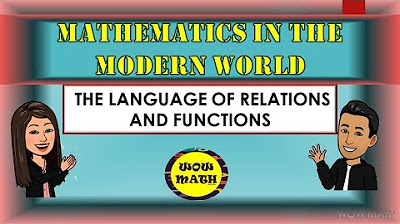Introduction to Partial Ordering
Summary
TLDRThe video script discusses a range of topics, from office presentations to complex relations in mathematics and linguistics. It touches on the concept of partition and its significance in organizing relationships before certain actions, like elections. The script also delves into reflective, symmetric, and transitive properties, as well as elements and their relations in various contexts, including dictionaries and social orders. The conversation shifts between practical examples and abstract ideas, offering insights into both theoretical and everyday applications. The content blends technical definitions with everyday relationships, making it both educational and thought-provoking.
Takeaways
- 😀 The presentation discusses the importance of understanding relationships and elements in various contexts, such as office presentations, student needs, and educational examples.
- 📈 The script mentions the significance of '151 Twister Disposal and Drinks,' which seems to be a key topic, possibly related to waste management or a specific project.
- 🎓 It emphasizes the need for students to grasp the concepts of 'AF, BE,' and 'IDM' for discussing examples and understanding the differences between 'avatars' and 'incomparable elements.'
- 🗣️ The presentation seems to involve an interactive element where the audience is encouraged to consider and discuss the elements and their relationships.
- 🔍 There's a focus on the importance of using elements in our lives, with a mention of 'news relation,' 'savory elements,' and 'obscurity' in relation to dictionary words.
- 🌐 The script touches on the concept of 'relation' and 'consistency' in the context of 'all wallpapers,' suggesting a discussion on patterns or themes across various subjects.
- 🏆 The term 'Bigg Boss' is mentioned, which might indicate a reference to a popular reality show or a metaphor for a significant event or concept.
- 📚 The script includes a discussion on the relationship between 'R1' and 'r2,' which could be variables, categories, or stages in a process or study.
- 📊 There's an emphasis on the importance of 'reflective' and 'antisymmetric' properties in relationships, which might be referring to mathematical or logical concepts.
- 📝 The presentation concludes with a call to action for the audience to subscribe and engage with the content, suggesting that the script is part of an educational or informative series.
Q & A
What is the main topic discussed in the script?
-The main topic discussed in the script appears to be about relationships, specifically the importance of understanding different types of relationships and their elements.
What does the script suggest is important for students to consider?
-The script suggests that students need to consider the importance of elements in relationships, such as communication, understanding, and the ability to resolve conflicts.
What is the significance of the term 'ABC' mentioned in the script?
-The term 'ABC' is not clearly defined in the script, but it might be an acronym for certain elements or aspects that are crucial in the context of relationships or presentations discussed.
How does the script relate to the concept of 'Deflection'?
-The script mentions 'Deflection' in the context of relationship elements, possibly referring to the ability to divert or change the course of a conversation or a situation in a relationship.
What is the role of 'Elements' in the script's discussion?
-The role of 'Elements' in the script is to highlight the various components that make up a relationship, such as trust, respect, and communication, which are essential for its success.
What does the script imply about the importance of 'Order' in relationships?
-The script implies that 'Order' is important in relationships as it might refer to the sequence or structure that helps maintain harmony and understanding between the individuals involved.
How does the script discuss the concept of 'Obstructionism'?
-The script discusses 'Obstructionism' possibly in the context of political relations or as a metaphor for obstacles that can arise in personal relationships, hindering progress or communication.
What is the significance of 'R1' and 'R2' mentioned in the script?
-The significance of 'R1' and 'R2' is not explicitly clear from the script, but they could represent different stages or types of relationships or reference specific examples used in the discussion.
How does the script relate to the concept of 'Independence' in relationships?
-The script might relate to the concept of 'Independence' in relationships by suggesting that individuals should maintain their autonomy and not solely rely on their partners for personal growth or decisions.
What does the script suggest about the role of 'Reflection' in relationships?
-The script suggests that 'Reflection' plays a role in understanding and improving relationships by allowing individuals to look back on their actions and interactions to learn and grow.
How does the script discuss the importance of 'Transitivity' in relationships?
-The script discusses 'Transitivity' possibly in the context of how relationships can change or evolve over time, moving from one state to another, which is a characteristic of transitive relationships.
Outlines

This section is available to paid users only. Please upgrade to access this part.
Upgrade NowMindmap

This section is available to paid users only. Please upgrade to access this part.
Upgrade NowKeywords

This section is available to paid users only. Please upgrade to access this part.
Upgrade NowHighlights

This section is available to paid users only. Please upgrade to access this part.
Upgrade NowTranscripts

This section is available to paid users only. Please upgrade to access this part.
Upgrade NowBrowse More Related Video

Materi Matematika Kelas 8: Relasi dan Fungsi

THE LANGUAGE OF RELATIONS AND FUNCTIONS || MATHEMATICS IN THE MODERN WORLD

Relations and Functions | Algebra

MATERI MATEMATIKA YANG WAJIB DIKUASAI UNTUK MENGERJAKAN SOAL-SOAL OSN FISIKA SMA

ഒരു രാജ്യത്തിന്റെ ജനനത്തിന് തന്നെ കാരണമായ ചുഴലിക്കാറ്റ് | Bhola Cyclone

Introduction to Vector Analysis - Vector Analysis - Electromagnetic Field and Wave Theory
5.0 / 5 (0 votes)